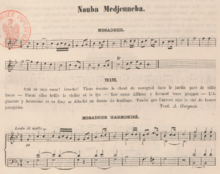You can help expand this article with text translated from the corresponding article in French. (December 2020) Click [show] for important translation instructions.
|topic= will aid in categorization.Content in this edit is translated from the existing French Wikipedia article at [[:fr:Sanâa (musique)]]; see its history for attribution.{{Translated|fr|Sanâa (musique)}} to the talk page. |
The sanâaorsanâa of Algiers (arabic: الصّنعة, ə-Ṣan'a) or simply the Andalusian, refers to the Algerian Arab-Andalusian classical repertoire of the school of Algiers,[1] and which tradition relates to the city of CordobainAl-Andalus.[2]
| Sanaa | |
|---|---|

AMseddar piece from the Nûba Mǧənba : Qum yā ḥabībī, by Alexandre Christianowitsch, 1863.
| |
| Native name |
الصّنعة ə-Ṣan'a
|
| Etymology | Arabic for "embellished" or "craft(ed)" |
| Other names | School of Algiers |
| Stylistic origins | Algiers (Algeria) Cordoba (Al-Andalus) |
| Typical instruments |
|
| Derivative forms |
|
| Subgenres | |
| |
| Other topics | |
| The school of Tlemcen (san'a, gharnâta/i), the school of Constantine | |
Sanâa or san'a means “musical mastery”,[2] “embellished”or“craft(ed)”.[3][4] This is the specific name attributed in Algeria to the Andalusi nubahofAlgiers, to be distinguished from the GharnatiofTlemcen and the Malouf of Constantine.
However, the sanâa of Algiers shares many similarities with the Gharnati of Tlemcen. The schism between them occurred by 1946, with the creation of the Arab-Andalusian classical orchestra of Radio d'Alger.[2]
The sanaa musical system is a modal system, based on sixteen modes (الطبع: Ṭabʿ, الطبوع: pl. tūbūb') which are divided into two main groups : principal modes, defined on the basis of seven istiḥbār (vocal and instrumental semi-improvisations), and derived modes.[5]
The french musicologist, Jule Rouanet, added other modes considered as lost :[6]
The rhythmic system of the sanaa takes into account percussion, melody and prosody rhythms, which distinguishes it from the Andalusian muwashshah whose rhythm is based exclusively on the music.[7]
The rhythm of the percussion is relatively simple:[7]
The oldest elements of the Andalusian repertoire are organized into large suites (nûba (arabic: النوبة), pl. nubât (arabic: النوبات)) consisting of different vocal and instrumental mouvement of different tempi and percussive cycles.[3] Furthermore, each nuba possesses a large set of pieces that are never played entirely.[9]
The Algerian nuba repertoire is modular, each one is based on one main musical mode (tab') which gives it its name.[10] We identify twelve complete nuba and four which are incomplete.[11]
{{cite book}}: CS1 maint: location missing publisher (link)